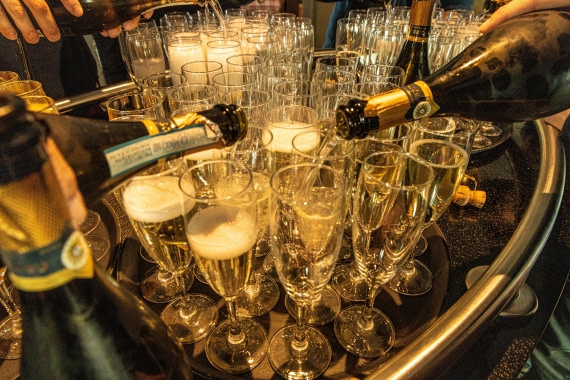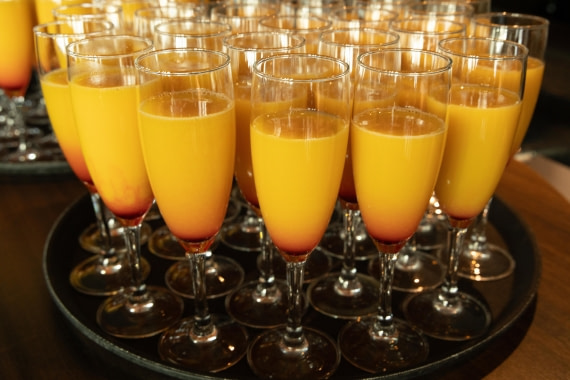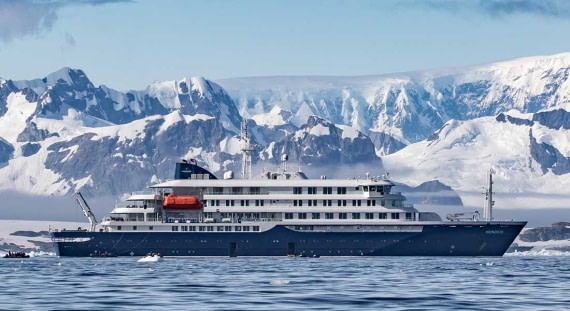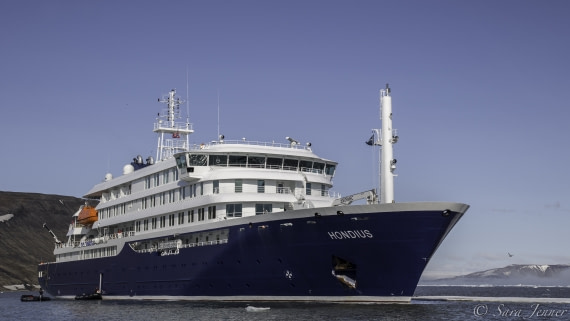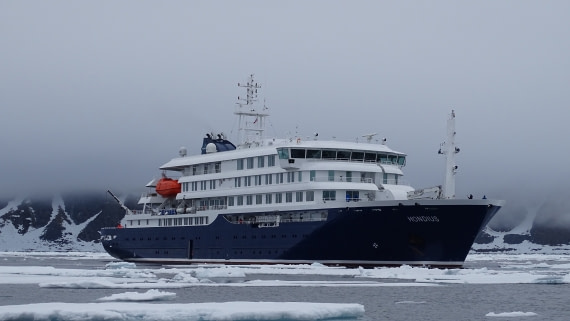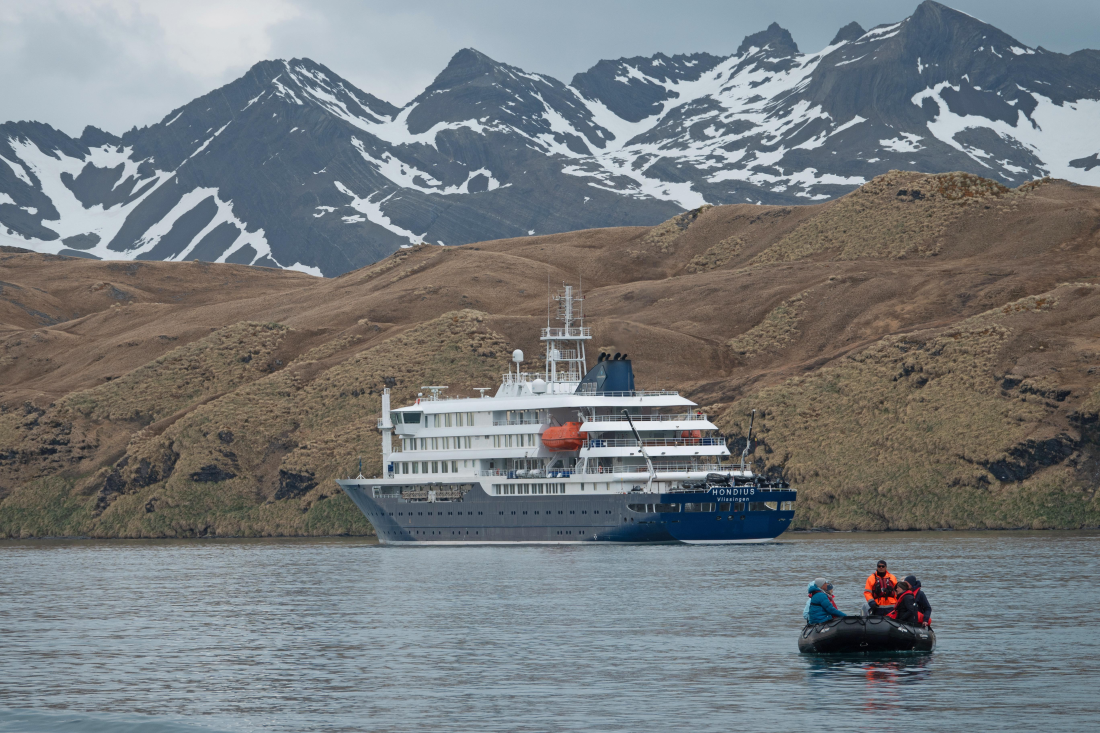| Datum: | 01.08.2023 |
| Positie: | 78°08.1’N / 015°37.1’E |
| Wind: | S 3 |
| Weer: | Overcast |
| Luchttemperatuur: | +10 |
Fotogalerij
Logboek
Day 1: Longyearbyen - Embarkation Day
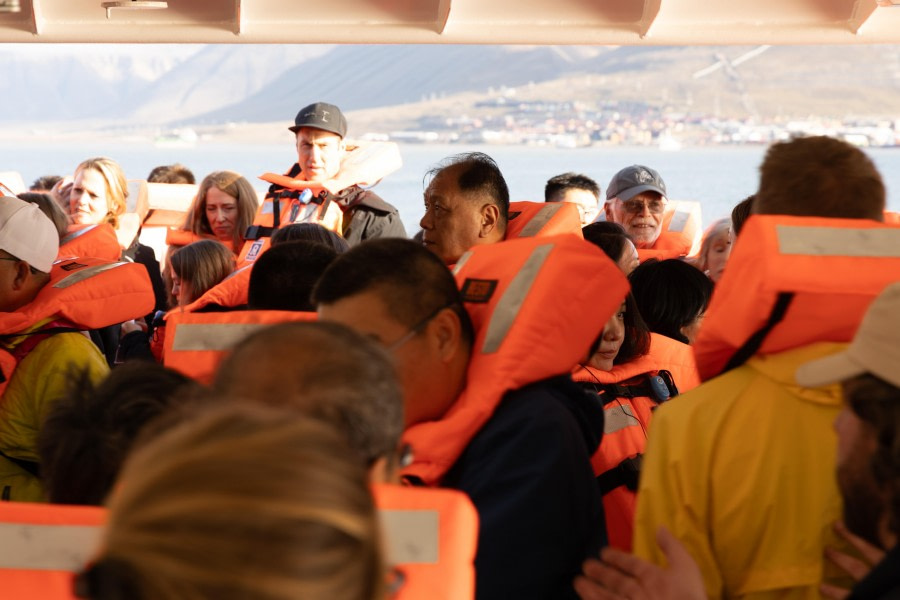
Day 2: Ny-Ålesund and 14 Julibukta
| Datum: | 02.08.2023 |
| Positie: | 79°00.0’N / 020°50.7’E |
| Wind: | ESE 2 |
| Weer: | Overcast |
| Luchttemperatuur: | +7 |
Day 3: Magdelenafjord
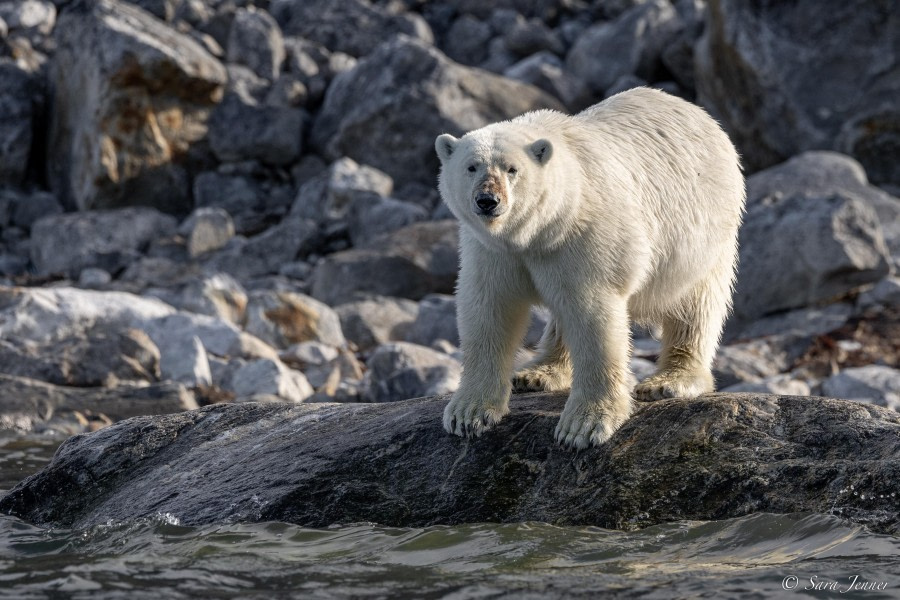
| Datum: | 03.08.2023 |
| Positie: | 79°33.6’N / 011°03.9’E |
| Wind: | NE 5 |
| Weer: | Cloudy |
| Luchttemperatuur: | +6 |
This day, as every day on Hondius it seems, begins with a scrumptious breakfast. Excitement fills the air as we prepare for our Zodiac cruise to Waggonwaybreen, an ice-filled wonderland nestled within the majestic Magdalenefjord. Our first destination is Graveneset, a historically significant site where we pay homage to the memory of 130 whalers from the 17th and 18th centuries. The serene atmosphere and remnants of past whaling activities evoke contemplation about humanity's relationship with nature.
As the Zodiacs draw near Waggonwaybreen, we find ourselves surrounded by ice formations and crystalline blue glaciers. Cameras click incessantly as we take in the surreal beauty of this Arctic landscape. En route to our next stop, we spot adorable Harbour Seals hauled out on the rocks near the shoreline. We maintain a respectful distance to observe these charming creatures in their natural habitat, capturing photographs for precious memories.
Back aboard, John gave us a fascinating lecture on the polar exploration in the Arctic, helping us to appreciate what they experienced and endured. Just as we were finishing a delectable lunch, excitement reached new heights as a polar bear was spotted swimming near our planned landing.
We quickly gathered on deck, binoculars in hand, to witness this magnificent creature in its natural element. The polar bear swam playfully, interacting with some seaweed, captivating our attention with its grace and strength. As the polar bear made its way to the shoreline, the expedition team promptly launched the Zodiacs for a closer encounter. We maintained a safe distance to respect the bear's space and minimize any disturbance to its natural behavior.
After spending considerable time observing the polar bear, we directed our attention to Smeerenburg where a group of walruses was hauled out. Their distinctive tusks and wrinkled hides presented a fascinating sight. As we approached the walruses from the sea, we were met with a pungent smell that filled the air. It was a stark reminder of the unique wildlife encounters that are synonymous with the Arctic region.
This was all followed by a recap with the expedition staff and a buffet dinner where we couldn't help but feel utterly satisfied by the day’s events.
Day 4: Monacobreen and Texas Bar
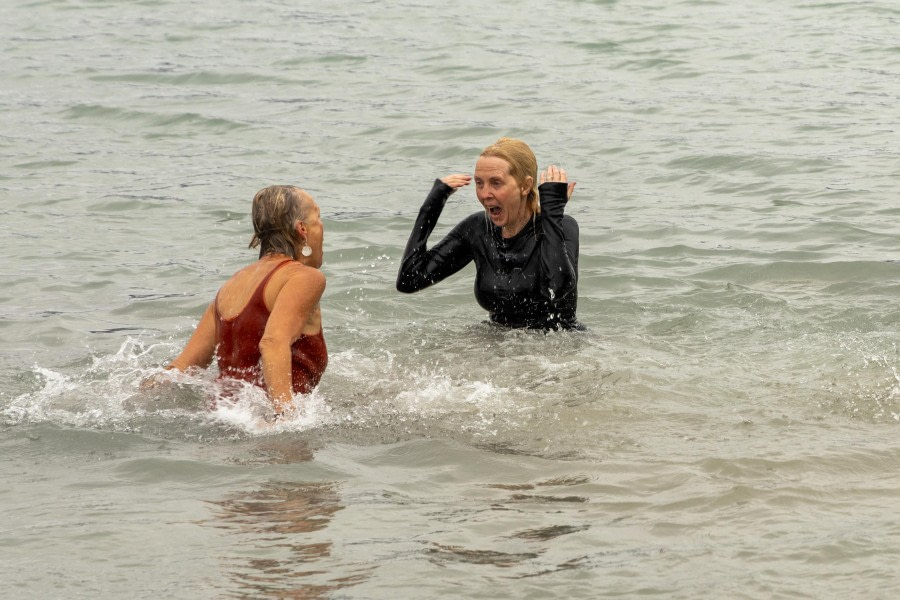
| Datum: | 04.08.2023 |
| Positie: | 79°.36’3N / 012°42.3’E |
| Wind: | SW 1 |
| Weer: | Overcast |
| Luchttemperatuur: | +8 |
The harsh Arctic morning: peaks of the mountains, shrouded in fog, that encircle Lifdefjord, icebergs frozen chunks, motionless upon the water, a gloomy sky veiled by gray clouds, and complete calmness – such a scene could only be glimpsed by looking out through the porthole or window. Disconnected and infused with a sense of hopelessness, Sara's rendition of "Good morning, good morning, good morning!" harmoniously interwove with the fabric of this picture. Hondius silently cut through the water's surface, approaching the location of our morning landing – Texas Bar.
While we had breakfast, our guides had already boarded the Zodiacs and sped off to the shore for reconnaissance and scouting. But how could it be otherwise? This is the Arctic; behind every boulder, in every depression, a dangerous white predator might be slumbering. Hence it’s imperative to ensure with certainty that in the places where we are to stroll and admire the beauty of the northern wilderness, none of them are present.
And here we are on the shore! Clad with lichen-covered rocks, sparse tundra vegetation, a pebble beach, a tiny cabin nearby, with a wooden plank inscription on its wall that reads "Texas Bar." If you step inside, you can see a row of empty bottles from strong spirits – that's where this name comes from! The cabin is inhabited: locals occasionally stop here for a break, to hunt rock ptarmigans and foxes, and sometimes use it as a base for kayaking and skiing trips.
Contrary to the weather forecast, visibility was good. Only from time to time did fog start to accumulate in the valley of the nearby glacier, swirling, thickening, yet not daring to launch an attack and engulf the entire coastline, along with the place of our landing. In the dense blanket of clouds, now and then, a gap forms here and there, through which the sun peers dazzlingly, causing the icebergs to sparkle.
We wandered through the tundra, striving to etch every corner, every cliff, every plant into memory, attempting to ascend every hill where one of the guides stood. Glaucous Gulls lazily flapped their wings above us, occasionally breaking the silence with their ominous squawking – mournful and drawn out – sending a slight shiver down the spine. Overhead the Blacklegged Kittiwakes, Arctic Terns, and Brunnich’s Guillemots darted to and fro. An Arctic Skua, perched on a massive boulder, would periodically take off and chase after a passing Kittiwake. Although late in the Arctic summer, flowers still had the power to bring us joy. Granted, a significant portion had already faded, yet a shortage of this geobotanical delight was hardly noticeable. Yellow Mountain Saxifrage formed cushions around us, here and there, one could still spot belated blooms of Mountain Avens. Minuscule Knotweed, drooping Saxifrage with its melancholic air, and believe it or not, Purple Saxifrage too!
Unbelievable as it might sound, even this Saxifrage, whose blooming season spans the end of May and the beginning of June, hadn't completely withered yet. However, the Wooly Lousewort had already faded, taking on a truly haunting appearance: leaves and stems turned reddish, resembling cobweb clusters and threads enveloping the stem, now even more visible than before. All of this evoked the thought that the same planet that is the homeland of this parasitic plant is the same one from which the terrifying Xenomorph creature of Ridley Scott's "Alien" film hails. On the bright side, Arctic Mouse ear and Fringed Sandwort were in full bloom around, unquestionably adding a touch of vibrancy to this eerie tableau.
Besides everything else, our guides brought four bags of towels to the shore. Why, might you ask? Well, to encourage the bravest among us to get into the water and have a polar plunge! There were quite a few brave souls among us! We barely had enough towels. The water wasn't just cold; it was achingly cold! When you entered, it took your breath away. Step by step, a bit further... And now you can dive! Inhale deeply and – splash! – you plunge in headfirst. You emerge on the shore and, miraculously, you don't feel any cold! Our body's protective mechanisms kick in! All pores of the skin seal shut to minimize heat loss. All set, now you can dry off with a towel, get dressed, and head back to the ship where lunch is just about to be served!
While we had lunch Hondius ventured deeper into Liefdefjord, approaching the stunning Monaco glacier. This glacier is famous not only for its picturesque beauty but also for its high activity. This implies a decent chance of witnessing calving. No shore landings were planned. Instead, in order to approach the glacier at a safe distance and examine it in detail, our guides arranged a Zodiac cruise for us. We cruised in the Zodiacs to explore unforgettable views and, perhaps, some adventures. We moved forward, maneuvering around massive (by Spitsbergen standards) icebergs and slowly making our way through brash ice. It wasn't always easy to move steadily; our guides had to occasionally engage reverse gear, make sharp turns, and perform other expert maneuvers. Birds circled above us, as always. They ranged from cheerful Kittiwakes to ominous Glaucous Gulls, Arctic Terns, and even rarer avian residents like the Great Skua and Ivory Gull.
And what about the glacier? The glacier truly held our attention, as if it were alive. There was a constant deep rumble, occasionally escalating into thunder. We witnessed huge chunks breaking off here and there from the glacier's front, sending sprays soaring to the sky, transforming into icebergs upon crashing into the sea. Each of these chunks, aside from the spray, caused a tsunami-like wave, but, at a safe distance, we were in no danger.
In the midst of the cruise, out of nowhere, Sara appeared on a Zodiac with a flag and started treating everyone to hot chocolate. Naturally, the eager ones didn't keep her waiting, so a genuine flotilla of boats formed around her. We had to wait a bit. No big deal, there was plenty of hot chocolate for everyone!
We returned to the ship just before dinner. An open-deck barbecue was planned, but alas, the Arctic nature showed its character – it started to rain, so the barbecue had to be moved indoors to the restaurant. Well, no big deal! We had a fantastic dinner in the restaurant as well.
A truly fascinating day. And most importantly, this isn't the end yet! There will be more days, more new adventures! Raise the anchor! Full speed ahead!
Day 5: Ice Edge
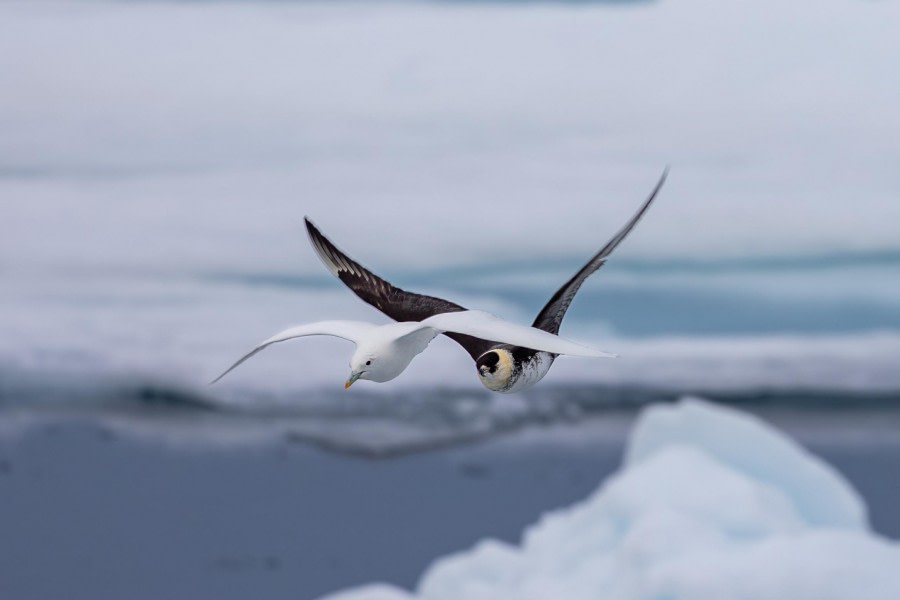
| Datum: | 05.08.2023 |
| Positie: | 79°35.8’N / 018°29.5’E |
| Wind: | S 3 |
| Weer: | Foggy |
| Luchttemperatuur: | +5 |
Today we got to sleep in a bit with our wakeup call only being at 07:45am. It was going to be our day on the ice edge searching for wildlife with our main goal of spotting more polar bears. We reached the ice around 07:00aa and members of our expedition staff were already at the bridge with their binoculars to scan the ice floes for bears. Searching for bears feels a bit like finding that needle in a haystack, but we know they’re here and with their yellowish coloured fur we should be able to spot one sooner or later. But first we enjoyed breakfast.
After breakfast we had time to spend on the outside decks while soaking in this vast and seemingly endless vista of ice floes. At 09:15 Sara invited us all to join and attend her interesting presentation about polar bears. She had hardly started when she got a message from the bridge, a polar bear had been spotted. What better way to interrupt a polar bear presentation by the main character itself!
The bear was very active. It was walking on the ice and often disappearing out of our sights as it was swimming too. At times we were expecting it to climb out of the water, but instead it decided to dive and swim under the ice floes to the other side. With the ice not being very strong this late in the season, the bear may have chosen this way to avoid using unnecessary energy. Climbing on the ice takes a lot of energy and this bear was clearly avoiding doing so. After some time, we lost sight of the bear and, in order not to disturb it in its search for food, we decided to move away. We thought we had left the bear behind, when it suddenly resurfaced quite close the ship and looked briefly at us before diving back in. Polar bears can hold their breath for 2-3 minutes and with all this ice around you can easily lose them.
Sara continued her lecture while the staff on the bridge continued the search. Murphy’s Law certainly applies when looking for bears as right before lunch time Sasha spotted our second bear of the day. It was asleep on a larger ice floe and the Captain decided to ‘park’ the ship in the ice hoping the bear would wake up sooner or later. We all ran out of the dining room to get a look, but when we saw the bear was not very active, we returned for a relaxed lunch.
Observing wild animals is amazing, but it also requires patience. We knew that this bear would become more active sometime, we just didn’t know when. So we decided to observe from a distance waiting for it to wake up. In the meantime, lectures were organized in the observation lounge and we were visited by a Minke Whale. Throughout the day, the Kittiwakes entertained up with the swooping dives to feed near the ship.
By afternoon the rain from the morning was replaced with clear and sunny skies. To our surprise, an ice cream station appeared on the bow and we all enjoyed a delicious treat. This bear must have really enjoyed the day off on Saturday, as it hardly moved. A few times we got very excited when it stood up, only to be disappointed shortly after when the bear laid down again. Maybe it knew that we were waiting for it?
Around 19:00 Murphy’s Law struck again. After almost 6 1/2 hours of waiting, the bear got up on its feet and started walking just as a plated dinner was served in the dining room. Unfortunately, our patience wasn’t rewarded as the bear walked in all kinds of directions, but never in the direction of our ship. Nevertheless, it was a great day and although the second bear didn’t do what we hoped, it was still amazing to see a polar bear in its natural environment. Knowing that tomorrow will be a more active day meant that it was time to get some sleep!
Day 6: Alkefjellet and Wahlbergøya
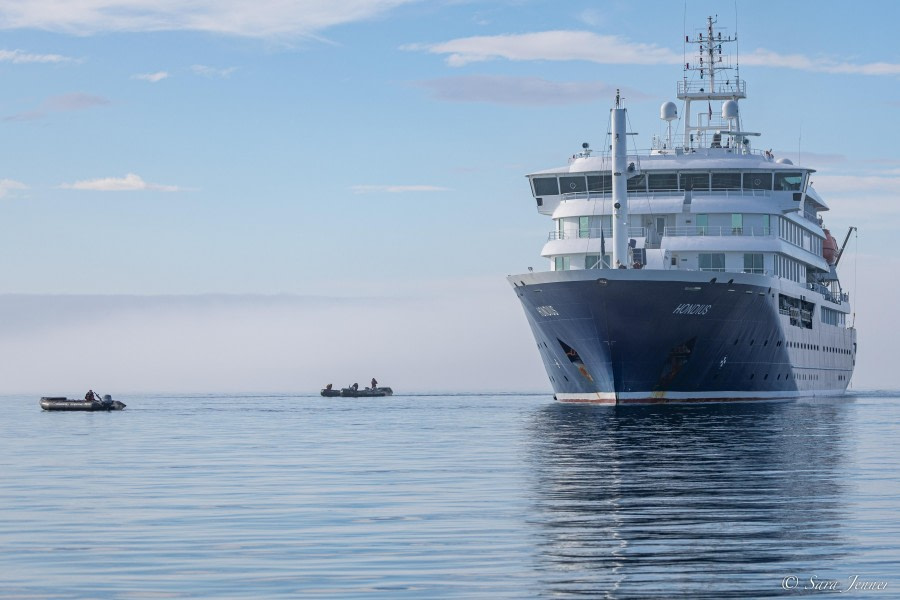
| Datum: | 06.08.2023 |
| Positie: | 79°35.8’N / 018°29.5’E |
| Wind: | S 3 |
| Weer: | Foggy |
| Luchttemperatuur: | +5 |
Today was a day of changes. From the early hours of the morning, our expedition leader was up making decisions based on the weather. Our original plan was to land in Parrypøya and then Zodiac cruise Phippsøya in the afternoon. However, as is often the case with these very northern islands in Svalbard, something got in our way. This time it was the weather. The fog was thick.
To make sure we would still make it to the next land and a good place to explore, Sara made the decision early, then we raced on down into the Hinloppenstrait. It was a journey in fog all the way. Initially we had nearly two knots of current with us which helped up make good speed. We passed over a stark color change in the water where cold, dense, fresh, sediment rich glacial water was meeting the northern ocean currents. There was an increase in bird life, but no mammals broke the glassy surface. As we made our way south, Charlotte gave a great introduction to the different types of whales that are found in Svalbard. It is very useful to be able to learn about what to look out for and fascinating to know more about the incredible surroundings. The whales are an essential part of the ecosystems here. Charlotte was able to share her knowledge of these incredible species that she has gained through her vast experience in their home: the oceans of the world.
We arrived within a mile of Alkefjellet at 11:00am, however it was still nowhere to be seen. The fog had not yet burnt off and there was not much wind to blow it away. Regardless of this problem, we optimistically prepared for the cruise. Sure enough, by the time we were loaded into the Zodiacs, the impressive mount guillemot, or Alkefjellet, was visible. We would soon see how these cliffs get their name.
We started at the east end of the cliffs where a glacier pours down a steep slope to the sea from a higher plateau area. The crevassed glacier was laden with sediments, accumulated from higher in the mountains and brought down on this conveyor belt system. To the right of the glacier, the cliffs showed an interesting color change. At the base of the cliffs are white-layered rocks, while sitting directly on top are black rocks forming vertical pillar structures. Again, at the upper cliffs, the hard white parallel layers of white rock reappear. This is what we call an intrusion. A large volume of magma pushed its way in between some limestone layers at a time when the Atlantic Ocean was beginning to open. This tough black dolerite rock is what forms the impressive cliffs of Alkefjellet. The neat horizontal layers are a favorite perching place for the birds, making this sea cliff home to over 60,000 breeding pairs of Brünnich’s Guillemots.
As we went to the south along the sea cliffs, we came across many of these smart black and white birds in the water. The Brünnich’s Guillemot come to Svalbard, here in the high arctic, every summer for breeding. They travel out to sea during the winter months, where they spend their time fishing off the coast of Greenland and Labrador. It is in August that the young will start jumping from the cliffs in synchrony and heading to the water to begin the long swim to the open water.
Many don’t survive this jump or the long swim, during which time they must also learn to fly. This leads to our next observation. As we moved south along the cliffs, Arctic Foxes were spotted. They are in the perfect place for picking up any dead or injured birds that fall to the base of the towering cliffs.
As we were plodding along the coastline, observing the beautiful, small fluffy Arctic Foxes scurrying around, a swimming Polar Bear was spotted! This is an unusual sight at the steep cliffs of Alkefjellet. The small birds and eggs with not make much more than a snack for the top predator in the Arctic. We observed the bear from a distance as it swam, carefully getting out of the way. The playful foxes were giving a great show. By now there were four squabbling in the grassy slopes below the cliffs.
The Polar Bear climbed ashore, which gave us a fantastic opportunity to observe it and its behavior. It was so impressive to see the animal from up close as it walked up the slope and across the scree. What enormous animals they are! After three quiet and slow ‘drive-bys’ in the Zodiacs, we withdrew to make sure not to intrude. It was a rare experience to get close enough to see how the bear moves, without disturbing it. It moved on and so did we, towards the Guillemot cliffs.
The ceiling of birds, going-and-coming from the cliffs, made us feel that we were inside a dome lined by accelerating birds. Occasionally a large group of Guillemots would take off in synchrony and fly out to sea together in search of crustations and small fish. The black rocks have turned white with every digested fish that the Guillemots deposit on the cliffs. This all plays a role in the ecosystem here, providing essential nutrients to create the bright green patches of vegetation below Svalbard’s bird cliffs.
As the fog rolled in again, surrounding the upper towers of the sea cliffs, we were left with an eerie and atmospheric scene with the soundtrack of squawking birds echoing round the cliffs.
Day 7: Palanderbukta, Hinlopen Strait and Bråsvellbreen
| Datum: | 07.08.2023 |
| Positie: | 79°34.3’N / 020°41.8’E |
| Wind: | ESE 6 |
| Weer: | Cloudy |
| Luchttemperatuur: | +5 |
Today we woke up to the soft sound of Sara’s voice: “good morning, good morning, good morning.” We had expected fog, but luckily it was clear made our planned landing at Palanderbukta on North East Land, the second biggest island in Svalbard of nearly 15,000 square kilometers. It is pretty much a desert with very little soil and vegetation.
The long hikers landed first, all eager for a fit, fast and furious hike. They set off into the distance, their legs moving like pistons. The medium and short hikers followed shortly afterwards, followed by lastly the Sino Star group doing scholastic research. They soon found that the area was littered with beautiful fossils, including snails, shells, Brittle Stars and coral. This area lifted was 60 metres above sea level 12,000 years ago when they heavy ice melted at the end of the ice age, hence the reason for the whale skulls far up the beach. The fresh air made us feel alive, and after the hike and a fabulous lunch we were all ready for a nap.
This afternoon began as an expedition afternoon looking for wildlife. We visited the whale carcass at Wahlbergoya. A bear feeding on it was seen from the Bridge. Bad luck for us, the bear had slipped away as we approached. We continued our search and, what do you know, a bear was spotted sleeping on one of the small rocky islands! As we got our eyes and binoculars onto it, more bad luck, as the fog poured in and swallowed up the bear.
As recap and dinner rolled on, we slowly edged closer to Brasvelbreen, a 180km long ice cap in Svalbard. Beautiful ice bergs eerily past the ship with their greatness, Brasvelbreen loomed in the distance and eventually later in the evening, the ice cap showed itself in all its glory and might. Wow, what a sight! Now it was time to wander into sleep as yet another fantastic day was ending.
Day 8: Freemansundet and Russebukta
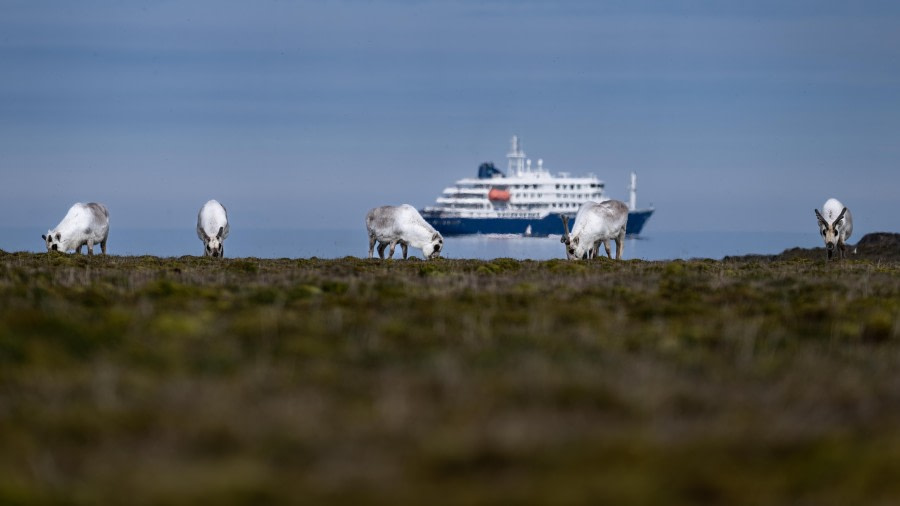
| Datum: | 08.08.2023 |
| Positie: | 77°54.0’N / 020°46.1’E |
| Wind: | E 2 |
| Weer: | Cloudy |
| Luchttemperatuur: | +10 |
This morning was the one morning that we actually didn’t want to find a bear, because we were hoping to land on Kapp Wahlberg. Kapp Wahlberg is a beautiful place with a canyon that is home to thousands of breeding Kittiwakes. We are allowed into the canyon and the birds allow us to come close and often we also see Arctic Foxes there. You can imagine it’s a great place for them to find food and feed their kits.
But it is also a very beary place, and this morning we, unfortunately, scouted a bear too close to the landing site to be able to run a safe operation. As the scouted bear was not actively walking, the captain and Sara decided to move on and look for other wildlife while we transferred to our next location.
What happened in the following hours was quite unique and incredible. We spotted bears everywhere (a total of 6), but they were either far up the slopes, or they were high up on the shoreline, making it difficult for us to get a good look from our Zodiacs.
Then we passed by Kapp Lee, where we had our most thrilling encounter. Two bears, presumably a mother and cub, were walking on the beach towards a large colony of Walrus. Walrus are usually not prey for the bears, as the risk of getting injured is too great. Walrus tusks are sharp and can be up to one meter long, so being perforated by such a tusk can be fatal to a bear. However, the young bear walked straight towards the Walrus, which alerted them and we could clearly see many of the Walrus were raising their heads to see what the bear would do. The young bear’s mother had probably taught it already that attacking Walrus is not a good idea. The young bear had a look, but then decided not to get too close.
It was a wonderful moment to see two Polar Bear walking on the beach in the bright sun with all those Walrus lying on the beach. After lunch it was time to stretch our legs. With that delicious coconut mousse still in our bellies, it was also good to do a bit of a workout. We landed at Russebukta and this time we were lucky because we didn’t find a bear ;). The weather was still gorgeous and perfect for some hiking. In Russebukta you can find many very old whale bones, but today our attention was drawn to the many flowers in bloom. The fluffy Cottongrass looked like white silky streetlights in the bright rays of the summer sun.
While walking across the boggy tundra, we saw several birds including Purple Sandpipers, Snow Bunting and Arctic Skua. More impressive was finding ourselves approaching several reindeer. We took our time to move closer to them slowly. When you don’t make any sudden moves, you can approach them quite closely. The Svalbard reindeer are endemic and, after they were hunted almost to extinction, they are now making a good comeback. Their numbers are estimated to exceed 20,000 animals which is a fantastic improvement. We were able to get close enough to see that they are really cute with their big dark eye patches and beautiful big brown eyes that stare at you curiously.
After dinner it was time for some classic relaxation, a movie, and popcorn. This evening the selected feature was Happy Feet. The lecture room was sold out and the popcorn irresistible. It was another wonderful day in the Arctic, but now it’s time to enjoy a well-deserved rest. Good night and see you tomorrow.
Day 9: Gåshamna and Burgerbukta
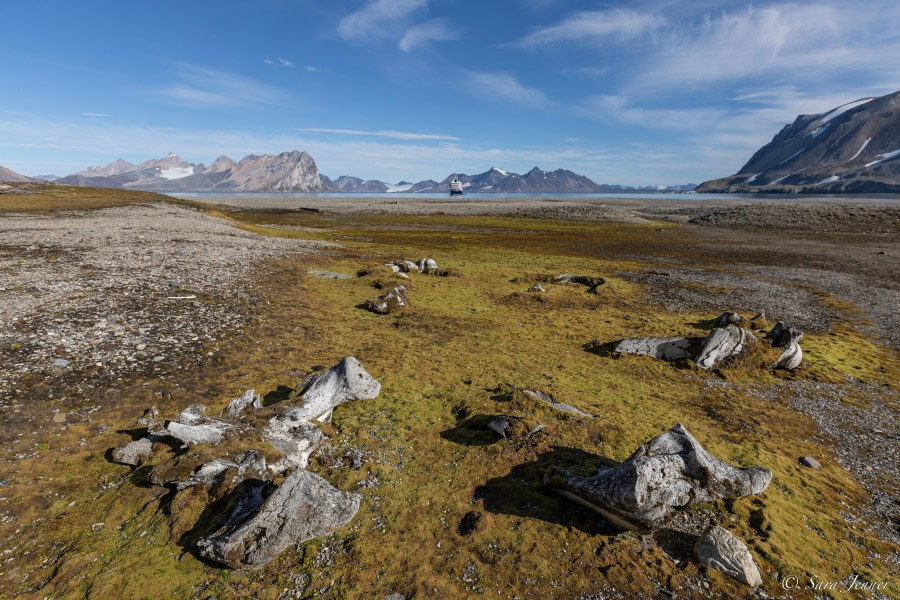
| Datum: | 09.08.2023 |
| Positie: | 76°56.6’N / 018°49.2’E |
| Wind: | NE 3 |
| Weer: | Sunny |
| Luchttemperatuur: | +6 |
Day 10: Longyearbyen - Disembarkation Day
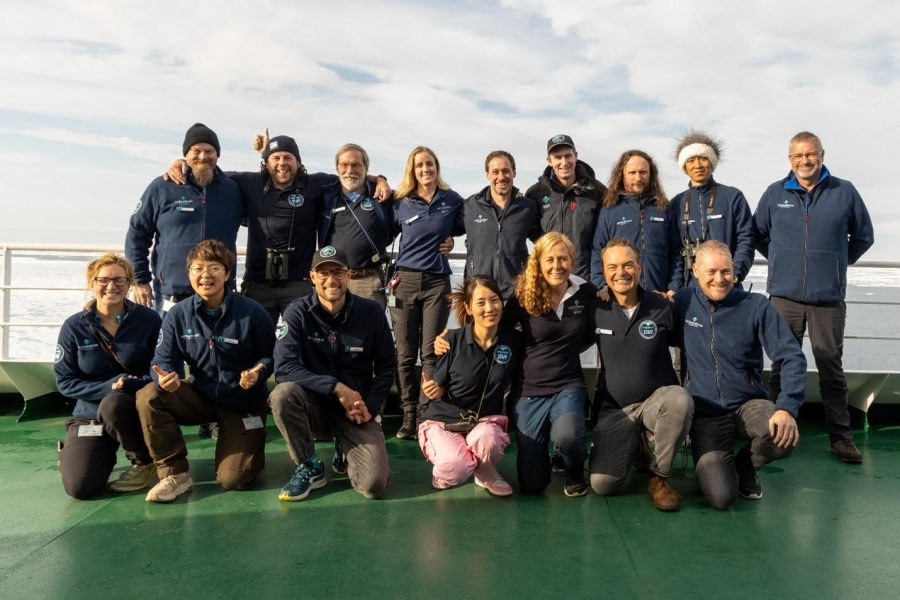
| Datum: | 10.08.2023 |
| Positie: | 78°14.0’N / 015°36.5’E |
| Wind: | NE 2 |
| Weer: | Cloudy |
| Luchttemperatuur: | +9 |
Well, the final day is here. Our bags are packed and left outside our doors for the staff to collect. After breakfast at 0900, we disembark the ship and say goodbye to Sara and all her team. What a team! We can’t thank them enough for all their knowledge and guidance on this trip.
Thank you for travelling with us on this voyage and for your enthusiasm, support, and good company. We hope to see you in the future, wherever that might be!
Total distance sailed: 1231 Nautical Miles Furthest north: 81°10.6’N / 22°34.0’E
On behalf of Oceanwide Expeditions, Captain Ernesto Barria, Expedition Leader Sara Jenner, Hotel Manager Michael Barnes, and all the crew and staff of M/V Hondius, it has been a pleasure travelling with you!
Aan boord van m/v Hondius
Hondius is 's werelds eerste geregistreerde Polar Class 6 schip en is van onder tot boven gebouwd voor expeditie cruises.
Meer over de m/v Hondius »


